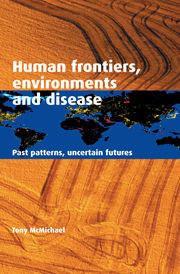Book contents
- Frontmatter
- Contents
- List of sources for illustrations
- Preface
- 1 Disease patterns in human biohistory
- 2 Human biology: the Pleistocene inheritance
- 3 Adapting to diversity: climate, food and infection
- 4 Infectious disease: humans and microbes coevolving
- 5 The Third Horseman: food, farming and famines
- 6 The industrial era: the Fifth Horseman?
- 7 Longer lives and lower birth rates
- 8 Modern affluence: lands of milk and honey
- 9 Cities, social environments and synapses
- 10 Global environmental change: overstepping limits
- 11 Health and disease: an ecological perspective
- 12 Footprints to the future: treading less heavily
- Notes
- Index
4 - Infectious disease: humans and microbes coevolving
Published online by Cambridge University Press: 05 March 2012
- Frontmatter
- Contents
- List of sources for illustrations
- Preface
- 1 Disease patterns in human biohistory
- 2 Human biology: the Pleistocene inheritance
- 3 Adapting to diversity: climate, food and infection
- 4 Infectious disease: humans and microbes coevolving
- 5 The Third Horseman: food, farming and famines
- 6 The industrial era: the Fifth Horseman?
- 7 Longer lives and lower birth rates
- 8 Modern affluence: lands of milk and honey
- 9 Cities, social environments and synapses
- 10 Global environmental change: overstepping limits
- 11 Health and disease: an ecological perspective
- 12 Footprints to the future: treading less heavily
- Notes
- Index
Summary
There will come yet other new and unusual ailments, as time brings them in its course… And this disease of which I speak, this syphilis too will pass away and die out, but later it will be born again and be seen again by our descendants – just as in bygone ages we must believe it was observed by our ancestors.
Girolamo Fracastoro De Contagione, 1546This chapter brings us to the biblical Fourth Horseman, pestilence. Despite the rather naive optimism of Western science around 1970 – when the US Surgeon-General, for example, declared that it was time ‘to close the book on infectious diseases’ – this horseman continues to ride on. Indeed, he has seemed to ride with new vigour over the past quarter-century.
During the 1990s there was much talk about the apparent ‘resurgence and emergence’ of infectious diseases. Americans were gripped by talk of ‘coming plagues’ and ‘killer diseases’. There is a real basis for this concern, although not quite of the melodramatic kind suggested by these popular accounts. The main issue is not the emergence of exotic new infectious diseases such as Ebola virus disease – although the advent of HIV/AIDS reminds us of the ever-present possibility of new epidemic development. Currently, the greater problem is that various ancient infectious diseases such as tuberculosis, malaria and cholera are increasing again within the world at large, and others that may have been quietly circulating for some time (such as cryptosporidiosis, Lyme disease and hepatitis C) have only recently increased to the point of being noticed.
- Type
- Chapter
- Information
- Human Frontiers, Environments and DiseasePast Patterns, Uncertain Futures, pp. 88 - 122Publisher: Cambridge University PressPrint publication year: 2001



